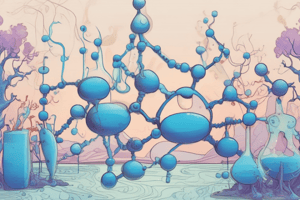Podcast
Questions and Answers
What is the product formed when R-C(=O)-Cl is reduced using lithium tri-t-butoxyaluminum hydride?
What is the product formed when R-C(=O)-Cl is reduced using lithium tri-t-butoxyaluminum hydride?
- R-C(=O)-H (correct)
- R-C(=O)-R'
- R-C(=O)-OH
- R-C(=O)-Cl
Which catalyst is used in the Rosenmund reduction method?
Which catalyst is used in the Rosenmund reduction method?
- Copper chromite
- Rhodium
- Palladium on barium sulfate (correct)
- Nickel
In the reaction involving lithium tri-t-butoxyaluminum hydride, what role does the reagent play?
In the reaction involving lithium tri-t-butoxyaluminum hydride, what role does the reagent play?
- It acts as a nucleophile.
- It functions as a base.
- It reduces the reactant. (correct)
- It oxidizes the reactant.
Which statement is true regarding the end product of both methods described for converting acid chlorides to aldehydes?
Which statement is true regarding the end product of both methods described for converting acid chlorides to aldehydes?
What is the primary characteristic of the solvent used in the lithium tri-t-butoxyaluminum hydride reduction?
What is the primary characteristic of the solvent used in the lithium tri-t-butoxyaluminum hydride reduction?
Flashcards are hidden until you start studying
Study Notes
Aldehydes from Acid Chlorides
-
Two methods are presented for converting acid chlorides to aldehydes: lithium tri-t-butoxyaluminum hydride reduction and Rosenmund reduction.
-
Lithium tri-t-butoxyaluminum hydride reduction:
- Uses lithium tri-t-butoxyaluminum hydride ($LiAlH(O-t-Bu)_3$) in ether.
- Reactant: R-C(=O)-Cl (an acid chloride)
- Product: R-C(=O)-H (an aldehyde).
-
Rosenmund reduction:
- Uses hydrogen gas ($H_2$) over palladium ($Pd$) on barium sulfate ($BaSO_4$) as a catalyst.
- Reactant: R-C(=O)-Cl (an acid chloride)
- Product: R-C(=O)-H (an aldehyde).
Studying That Suits You
Use AI to generate personalized quizzes and flashcards to suit your learning preferences.




